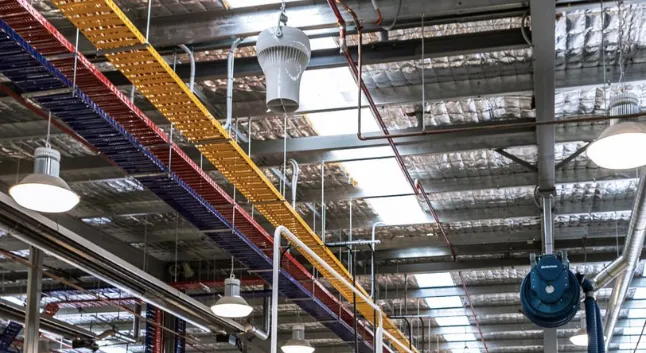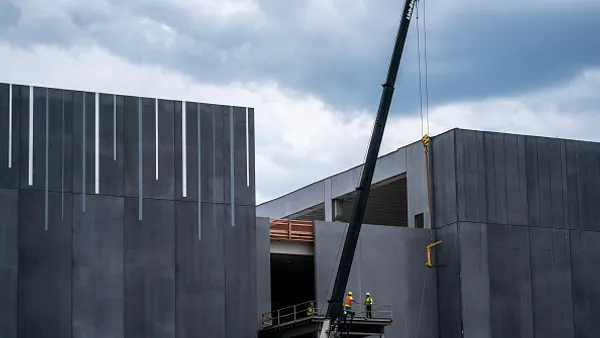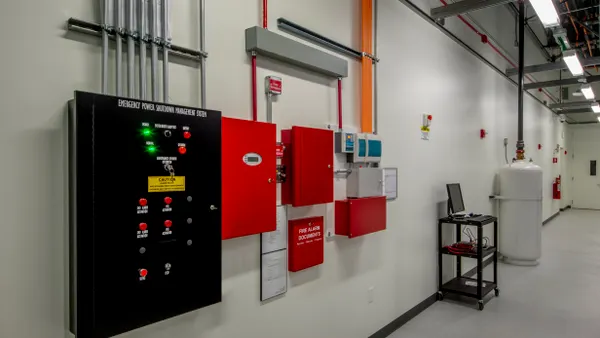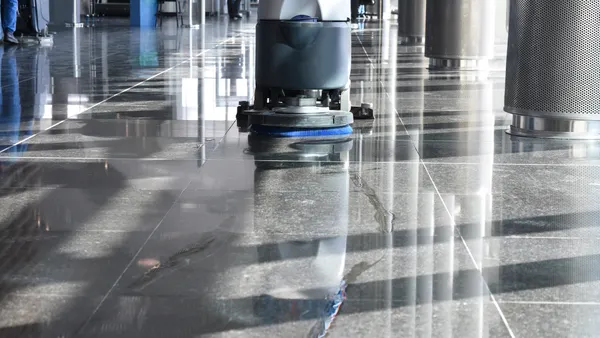Operators overseeing a large, hard-to-heat facility like a studio or manufacturing plant can magnify the heat that naturally collects below the ceiling by using what one company calls a jetted fan – a fan with a tapered nozzle that distributes the warm air to the floor below.
“The issue we typically solve is destratification,” Christian Avedon, director of sales and marketing of fan-maker Airius, told Facilities Dive. “Warm air rises. Cold air sinks. When you’re in a big space, you overheat the space to compensate for that stratification. We try to reduce that overheating by projecting that hot air from the ceiling down to the floor. Our fans act almost like a sprinkler system of air distribution."
Airius developed the high volume, low speed, or HVLS, fans when it tried to solve its own heating and cooling challenges. The company has a contract manufacturing business that uses overhead cranes in its toolmaking shop. Because of the clearance they need, the cranes make it hard to install ductwork below the ceiling for heating and cooling, so it designed fans with a wide intake in the back and a tapered nozzle in the front to redistribute the warm air to the workshop floor. There’s also a small, internal fan in the bottom of the fan for straightening the airflow as it comes out of the nozzle.

“We needed some small, compact device instead of the large HVLS fan to get that heat down on the floor,” he said.
The fans can supplement air conditioning, too. Disney uses the fans in several of its Florida studios, and in some ride queues, for cooling. “They’re even part of the attractions,” said Avedon. “We create an air moving effect as people come around corners and things like that.”
The Rock Lititz studio in Lancaster County, Pa., uses the fans for heating and cooling. The studio is where many rock music acts and other shows test their equipment and refine their production before they go on tour.
“It’s a big indoor space, like 100 feet tall,” he said. “We have a bunch of our products in there to help keep the space balanced, temperature-wise.”
The fans are intended to supplement whatever heating or cooling system the facility already has, Avedon said. Their value comes from taking the warm or cool air already there and redistributing it so additional heating or cooling units aren’t needed.
“There are a lot of situations where they can’t meet the heat requirement of the floor without adding more unit heaters, radiant heaters – whatever it is,” he said. “Because we’re able to recoup that warm air off the ceiling, it eliminates the need to add additional supplemental heating, so you can definitely do a lot more with less.”
Configuring HVLS systems
The fans create the most value when the HVAC intake and outflow vents are both near the ceiling, he said. When the vents are configured this way, the air gets trapped in a short cycling loop that prevents it from reaching the floor. With the fans, the air trapped in the loop can get redirected down. “Those are slam dunk situations for us,” he said.
The fan configurations need to be customized for each situation, he said.
“If you have a welding operation, for example, you don’t want that jet of air coming down onto whatever their work area is, because it will blow that gas shield from their torch,” he said, “or if you have heavy dust, like in woodshops.”
In cases like those, the fans are concentrated over circulation paths – the parts of the space designed for people to move about.
“With a 25 foot ceiling, you probably have a three-foot spread of that air column,” he said.
Although they’re mainly intended for big spaces, the company also installs them in offices.
“You see these drop ceiling tile grids, with a two by two square,” he said. “Those are about eight feet tall, typically, maybe lower in some cases. But, generally, stratification isn’t the problem. It’s more about adding additional air movement to help supplement the AC.”
The fans can play a role for organizations that want to lower their energy use or otherwise have a greener posture, too, he says.
“The less energy you’re using to maintain comfort in your building, you’re not only saving money but you’re also helping the environment by not having to use that energy in the first place,” he said.
The company can also add filters to improve indoor air quality.
“We do one with a photohydrionization ionizer made by a company called RGF Environmental, and another one, GPS Air, uses needlepoint bipolarization technology,” he said. “These help fight odors, mitigate the spread of bacteria, viruses, [volatile organic compounds] – things of that nature.”
“If you’re increasing comfort for workers, that’s going to help with their productivity and also help with the safety of the space,” he said. “If there’s, say, heat stress involved in the space and you can help them feel cooler, then that helps them stay sharper when they’re working vs. getting worn down from that heat stress.”












